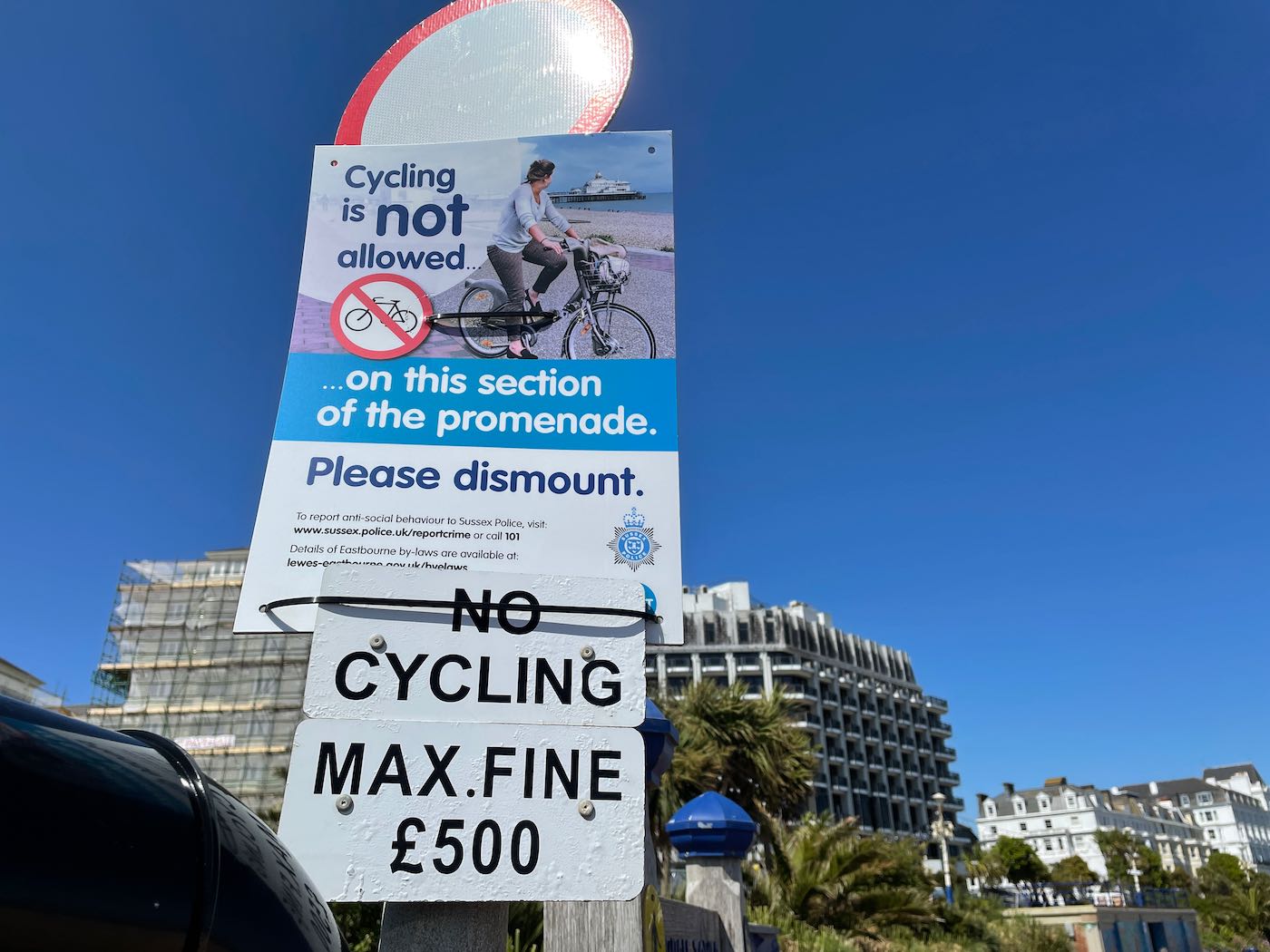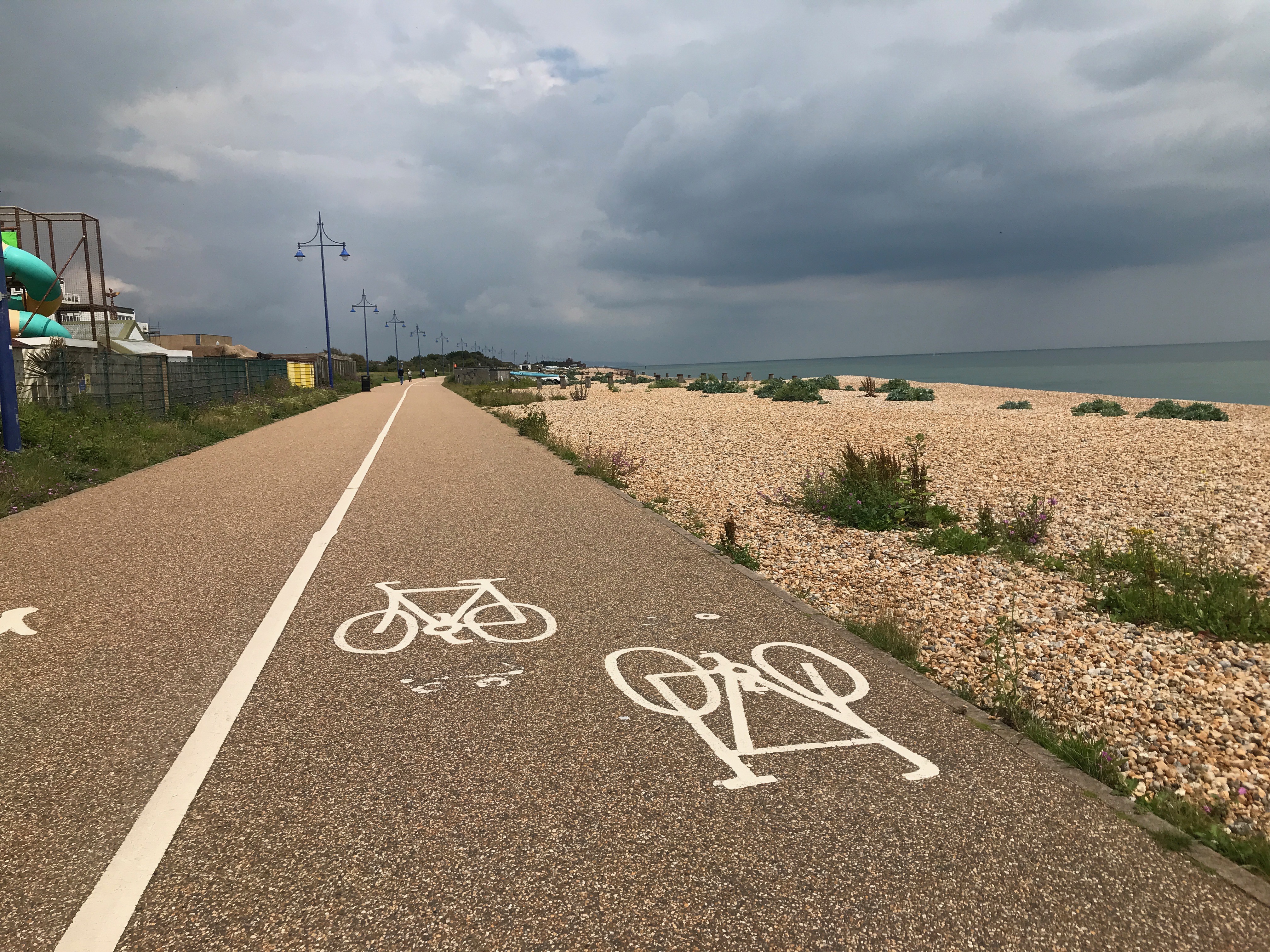Cycling by the sea still a distant prospect

NO solution to the decades-long quest for a safe cycle route along Eastbourne seafront appears imminent, despite an urgent need to offer viable alternatives to car use.
East Sussex County Council (ESCC), which is the highways authority, said it is “committed to delivering a continuous cycle route” but that it “cannot be delivered in the short term”.
It said this is because removing parking to create space east of the pier will need “extensive engagement and support” from stakeholders such as local businesses.
However, the council said it has allocated funding to “undertake feasibility work on potential options within the highway”.
To the west of the pier, a route has long been proposed using part of the middle path so cyclists are separated from people walking on the lower promenade.
Cyclists on the seafront currently share the pavement with pedestrians next to the road on some sections or cycle on the road itself.
ESCC’s lead member for transport and the environment Coun Claire Dowling declined our request for an interview on the subject, instead answering seven questions we put to her in writing.

The questions we asked and ESCC’s responses in full can be read here.
Last year, we looked at the issue of the long-running ban on cycling along most of Eastbourne's four-mile seafront in a three-part series.
Part one looked at the background of why you cannot cycle along the seafront, even west of the pier where there are two levels of promenade.
In part two, we heard the views of groups involved, including cyclists and pedestrians.
In part three, we asked both Eastbourne Borough Council and East Sussex County Council how they saw the way ahead.
Against the backdrop of a climate emergency, we wanted to find out what, if anything, had changed in the last eight months.
One of the questions we asked was what the Covid emergency travel fund money had been used for. ESCC said it has a total underspend of £831,185 and was liaising with Active Travel England to build “other schemes which support active travel in the county”.

We also asked why five newer cycle routes are planned for Eastbourne but there was still no imminent seafront option.
ESCC said a previous plan for a seafront route was prevented by an old bylaw so it was “not possible to progress this scheme” but it was still looking at potential options.
And we asked what had happened to developer contributions from Sovereign Harbour. ESCC said there was about £700,000 which has been “provisionally allocated” towards improving walking and cycling to and from that area.
These routes have been identified in the county’s Local Cycling and Walking Infrastructure Plan (LCWIP). It said the money was likely to be spent within the next three years.
Climate emergency pledges
ESCC declared a climate emergency in October 2019 and pledged to become carbon neutral “as soon as possible, and by 2050 at the latest”. This is the lowest target compared with neighbouring highway authorities.
It also only relates to the council's own activities. There is no reference to reducing other harmful emissions in the wider county.
Here are the different levels of pledges made by nearby authorities:
| Local authority | Pledge 1 | Pledge 2 | Target dates | Political control |
| East Sussex County Council | Council activities – carbon neutral | ‘As soon as possible’ or 2050 at the latest | Conservative | |
| West Sussex County Council | Council activities – zero carbon emissions | 2030 | Conservative | |
| Kent County Council | Council activities – zero greenhouse gas emissions | Whole county – zero greenhouse gas emissions | Council: 2030 Whole county: 2050 | Conservative |
| Brighton & Hove City Council | Council activities – carbon neutral | Whole city – carbon neutral | Both: 2030 | Green |
We asked Coun Dowling a second time for an interview about ESCC's pledge, based on the data above. We have not had a response.
Timeline
The saga of ‘No Cycling’ on the promenade and the lack of bike lanes segregated from traffic goes back decades.
The path is littered with well-meant plans, strategies, consultations and draft documents from two local authorities – plus ever-mounting frustration from cycling groups and others.
- 1994 – Sustrans report for East Sussex County Council outlines a seafront route
- 2012 – Eastbourne Cycling Strategy is produced by the borough council
- 2016 – Borough council votes in favour of seafront cycleway, but an old bylaw prevents it
- 2017 – Sustrans is asked again by county council for a report
- 2020 – County council is given £535,000 of emergency Covid travel fund
- 2021 – County council “to take forward” five routes, none along the seafront
The cycling group’s view
The Bespoke Cycle Group campaigns for safer cycling across Eastbourne. It was co-founded by Professor Scarlett McNally, a consultant orthopaedic surgeon working in Eastbourne, who has a particular interest in health and exercise coupled with transport issues.
Prof McNally wrote in a recent opinion article in the British Medical Journal*: “We should stop seeing the world through our windscreens.”
She cited data from the Department for Transport that showed 62% of UK adults say that it’s too dangerous to cycle coupled with the fact that 59% of car journeys are under five miles.
“A modal shift from cars requires better infrastructure for cyclists and pedestrians, with better public transport. Electric cycles allow older people and people with disabilities to cycle more easily, especially on hills and for longer distances,” she wrote.

Prof McNally also noted that pollution from road traffic contributes to many health conditions. And she quoted Government figures showing that 34% of men and 42% of women are not active enough for good health, pointing out that active travel – walking or cycling – can be the best way of fitting exercise into the day.
She concluded: “Let’s prioritise our health by making roads safer. We can’t afford not to if we want to look after our planet and the coming generations.”
* Reproduced from the British Medical Journal opinion column, 30 November 2022, with permission from BMJ Publishing Group Ltd.
Comments are welcome but they are pre-moderated
:: If you think this type of original journalism is better than reading PR handouts presented as 'news', please support me – it’s free to read but not free to produce. One-off donations are here or become a member here.


